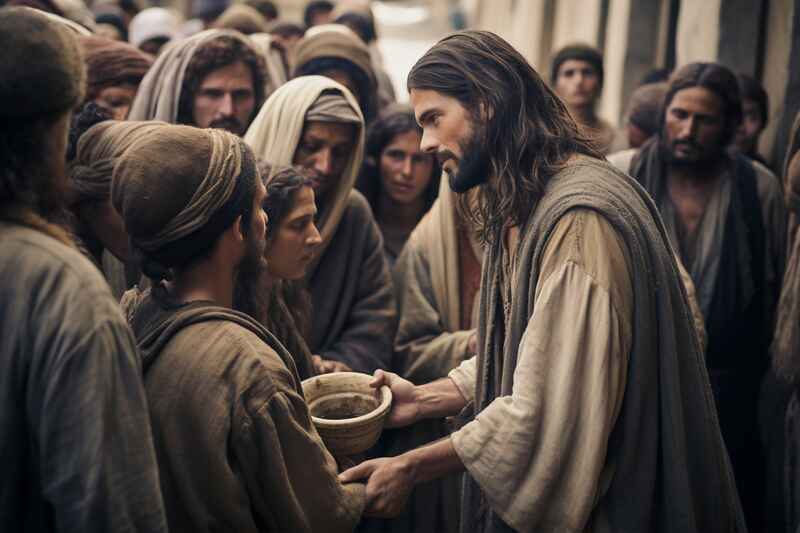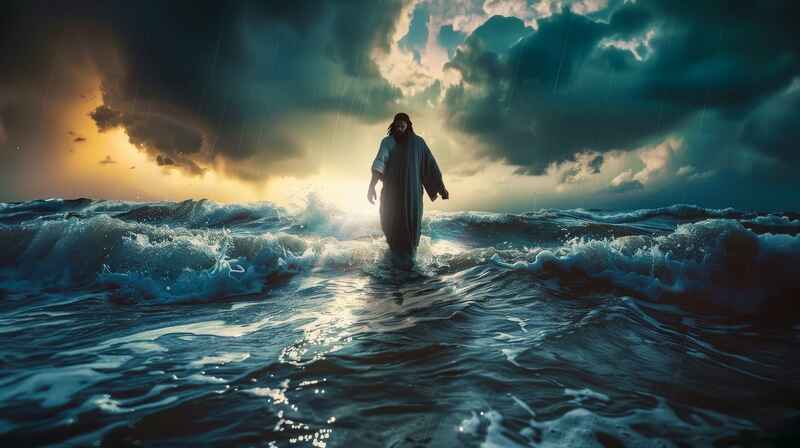Overview of Jesus' Miracles
The New Testament records a multitude of miracles attributed to Jesus Christ, demonstrating His divine authority and compassion. These miraculous events include turning water into wine, feeding thousands with minimal resources, and calming a storm.
Jesus' miracles often addressed immediate needs, such as healing the sick and raising the dead, illustrating both His divine power and His empathy for human suffering. Acts like feeding over 5,000 people with five loaves and two fish and feeding 4,000 more with seven loaves highlight His ability to transform scarcity into abundance.
Despite these famous miracles being documented, John 21:25 suggests even more occurred that went unrecorded, underscoring His unfathomable divine authority and mission.
Definition of a Miracle
A miracle is an extraordinary or supernatural event that reveals or affirms a divine message through a mighty work. Miracles were not only displays of divine power but also expressions of Jesus' compassion and love for humanity, as He frequently addressed individuals' immediate needs through His healing miracles and acts of mercy.
Purpose of Jesus' Miracles
Jesus performed miracles to showcase His divine authority and glorify God, explicitly confirming His identity as the Son of God. These miracles were not isolated acts of wonder but were deeply aligned with His mission to demonstrate love and compassion for others.
Jesus addressed immediate needs, providing comfort by healing the sick, calming storms, and even resurrecting dead persons. By doing so, He not only validated His messianic claims but also fulfilled ancient prophecies through His acts.
List of Miracles Performed by Jesus
Documented in the New Testament, Jesus performed over 30 miracles, ranging from healing ailments to controlling the natural world. Of course, many of the things that Jesus did could not have been recorded in such short works.
This section explores some of the most significant miracles Jesus performed during His earthly ministry.
1. Jesus Turning Water into Wine

One of the best-known miracles of Jesus, turning water into wine, marked the beginning of His public ministry. This event occurred at a wedding feast in Cana, as detailed in John 2:1-11.
Running short of wine, Jesus transformed water into fine wine, demonstrating His divine authority. This action not only saved the bridegroom from embarrassment but also revealed Jesus' glory, leading His disciples to believe in Him. This miracle was more than a display of power; it was a sign of His unique and divine mission.
2. Jesus Feeding the 5,000

The feeding of the 5,000 is a famous miracle, showcasing Jesus' ability to provide abundantly. Using merely five loaves and two fish, Jesus satisfied a multitude, as recorded in all four Gospels.
This miraculous event occurred in a desolate area, emphasizing His provision during scarcity. Leftovers filled twelve baskets, symbolizing God's overflowing blessings. This miracle highlights not only His divine power but also His compassionate care for both physical and spiritual needs, positioning Him as the bread of life.
3. Jesus Walking on the Water
After the miraculous feeding of the 5,000, Jesus sent His disciples ahead of Him by boat to cross the Sea of Galilee while He withdrew to a mountain to pray alone. During the night, as the disciples were struggling against strong winds and rough waters, Jesus came to them walking on the sea.
In Matthew’s account, the disciples were terrified, thinking they saw a ghost. Jesus reassured them, saying, "Take heart; it is I. Do not be afraid." (Matthew 14:27).
Peter then called out, “Lord, if it is you, command me to come to you on the water.” Jesus said, “Come.” Peter stepped out of the boat and began walking on the water toward Jesus, but when he noticed the wind, he became afraid and began to sink. He cried out, “Lord, save me!” Jesus immediately reached out His hand and caught him, saying, “O you of little faith, why did you doubt?” (Matthew 14:31).
When Jesus and Peter got into the boat, the wind ceased. The disciples were astonished and, in Matthew's account, worshiped Him, saying, “Truly you are the Son of God.”
4. Jesus Healing the Blind

Jesus performed several miraculous healings throughout His ministry, and among the most profound were those in which He restored sight to the blind. These acts revealed His divine authority over physical ailments and carried deep spiritual significance, often pointing to the necessity of faith and the reality of spiritual sight.
There are at least four distinct accounts in the Gospels where Jesus healed the blind:
- In Galilee, two blind men followed Jesus, crying out, “Have mercy on us, Son of David!” (Matthew 9:27–31). Moved by their faith, Jesus touched their eyes, and their sight was restored.
- At Bethsaida, Jesus led a blind man outside the village, applied spit to his eyes, and laid hands on him twice before his vision was fully healed (Mark 8:22–26). This unique, two-stage healing illustrated the gradual process by which some come to full spiritual understanding.
- In Jerusalem, Jesus encountered a man blind from birth. He made mud with His saliva, anointed the man’s eyes, and told him to wash in the Pool of Siloam. After washing, the man could see (John 9:1–41). This miracle was a powerful testimony not just of healing, but of Jesus as the “Light of the World,” exposing both physical and spiritual blindness.
- Near Jericho, Jesus healed Bartimaeus, a blind beggar who called out to Him in persistent faith (Mark 10:46–52). Though some tried to silence him, Bartimaeus cried even louder, recognizing Jesus as the "Son of David." His sight was restored, and he followed Jesus along the road. Matthew 20:29–34 mentions that there were two blind men healed in this setting.
In these healings, Jesus often used physical touch or substances like mud—not as magical tools, but as symbolic acts displaying His authority and divine compassion. More than just restoring physical sight, these miracles opened the eyes of the soul, offering glimpses into the Kingdom of God and revealing that true sight begins with faith.
5. Calming the Storm

The calming of the storm is a remarkable demonstration of Jesus’ authority over nature, as recorded in the Gospels of Matthew (8:23–27), Mark (4:35–41), and Luke (8:22–25). While Jesus and His disciples were crossing the Sea of Galilee, a violent storm arose, and the disciples, fearing for their lives, woke Jesus. He rebuked the wind and the waves, and immediately there was a great calm.
This miracle revealed Jesus’ divine power, prompting the disciples to ask, “Who then is this, that even the wind and the sea obey him?” (Mark 4:41). It also served as a rebuke of their fear and lack of faith, as Jesus asked, “Why are you so afraid? Have you still no faith?” (Mark 4:40).
Beyond the historical moment, this event offers a lasting spiritual lesson: that Jesus has authority not only over creation but also in the midst of life’s storms. His presence brings peace where there is chaos, encouraging believers to trust Him even in the most turbulent circumstances.
6. Jesus Raising Lazarus from the Dead
Raising Lazarus from the dead is one of the most powerful miracles performed by Jesus, illustrating His ultimate authority over death.
This event took place four days after Lazarus was buried, highlighting the miraculous nature of the resurrection. Jesus declared that Lazarus's illness was for God's glory, thus reinforcing His divine mission. By referring to Lazarus's condition as sleep before calling him forth, Jesus foreshadowed His own resurrection.
This miracle became a pivotal moment, showcasing His identity as the source of eternal life.
7. Resurrection of Jesus
The resurrection of Jesus is the cornerstone of Christian faith and His most profound miracle. Following His crucifixion, Jesus rose from the dead, signifying the triumph over death and promising eternal life to believers. This miraculous event occurred at the Church of the Holy Sepulchre in Jerusalem, believed to be the site of His resurrection.
Mention: The Gospels don’t specify a church, just a garden tomb near the site of the crucifixion (John 19:41). The Church of the Holy Sepulchre was built centuries later and is believed by many to mark the tomb, but it’s not stated in the Bible.
More than a historical event, it represents eternal victory and the promise of life restored through divine accomplishment. The resurrection underscores the fundamental tenet of Christianity - the hope of life beyond death through Jesus Christ.
Get Closer to God Today
4.9
Average Rating
|Over 5 Million Downloads
Significance of Jesus' Miracles
These miraculous events served to fulfill prophecies and affirm His identity as the Messiah. Through His acts of healing and other wonders, Jesus demonstrated both His compassion for humanity and the power of faith in God.
- Demonstration of Divine Power: Jesus's miracles showcased His divine power, revealing His authority over nature and human limitations.
- Invitation to Faith and Belief: Jesus performed miracles as a compelling invitation for others to recognize His divine identity and authority.
- Expression of Compassion and Love: At the heart of Jesus's miracles was His deep compassion for those in pain and suffering. His healing miracles emphasized not just divine authority but also profound love and mercy.
Comparing Jesus' Miracles with Other Religious Traditions
Jesus' miracles are widely regarded as distinct due to their strong ties with his identity as the Son of God. Unlike other religious traditions where miracles may serve various purposes, Jesus performed them to glorify God, aid others, and affirm his divine nature.
Miracles in Islam Attributed to Jesus
In Islam, Jesus is recognized as a prophet who performed miracles, which are detailed in the Quran. Notable among these is the miracle of a table laden with food sent to his disciples, as mentioned in the fifth chapter, "The Table Laden with Food."
The Quran also references other miracles attributed to Jesus, underscoring his unique status and confirming his role and message as a significant prophet in Islamic belief.
Current Perspectives on Miracles
In contemporary society, Jesus's miracles often face skepticism, mainly from those influenced by Enlightenment ideals that question supernatural interventions. Some modern Christians interpret these miracles metaphorically, viewing them as symbolic demonstrations of God's power rather than literal events.
This metaphorical interpretation allows believers to embrace the essence of the miracles without clashing with scientific reasoning.
Historically, the authenticity of miracles has sparked debates, with some religious institutions using belief in miracles to distinguish between orthodox and liberal Christians.
While some theologians remain open to the possibility of miracles, they may shy away from debates on their literal truth.
References:
Bibleref, John 20:30, https://www.bibleref.com/John/20/John-20-30.html, accessed 06.05.2025
The Holy Bible, New International Version. Zondervan, 2011.










